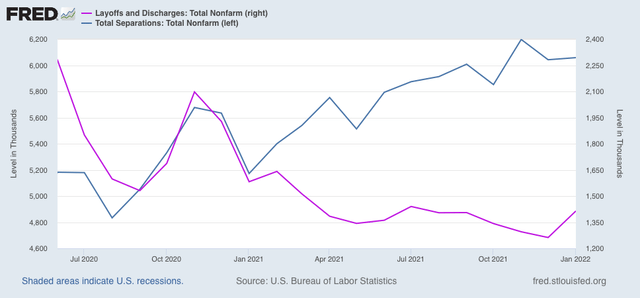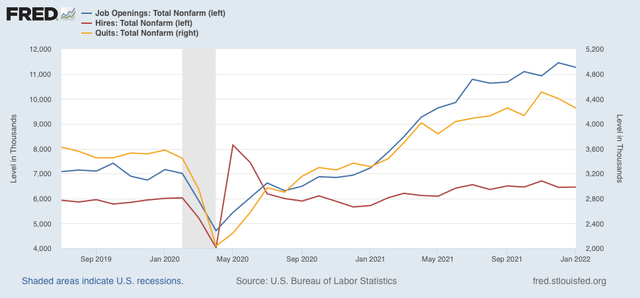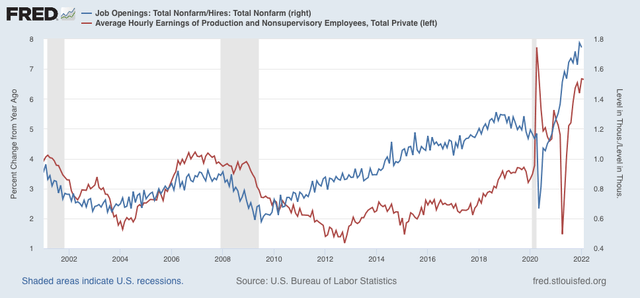- by New Deal democrat
The Census Bureau JOLTS report for January, released this morning, indicates that the jobs market continues to be nowhere near equilibrium - which continues to be a good thing for workers’ wages.
Several months ago I introduced the idea of a game similar to musical chairs, where employers added or took away chairs, and employees tried to best allocate themselves among the chairs. Because of the pandemic, there are several million fewer players trying to sit in those chairs, leaving many empty. As a result, wages have continued to increase sharply, as employers attempt to attract potential employees to sit in the empty chairs.
This pattern has continued, easing only slightly. There were also some significant revisions in past months’ data, some positive, some negative.
Layoffs and discharges (violet, right scale in the graph below) increased 152,000 to 1.414 million from their record low in December. Total separations (blue) rose 16,000 to 6.058 million (graph starts in June 2020 for reasons of scale):

Layoffs continue to be extremely rare.
Meanwhile, job openings (blue in the graph below) decreased 185,000 to 11.263 million from their revised record peak of 11.448 million in December. Openings have been gradually increasing to repeated record highs in the past 6 months. Voluntary quits (the “great resignation,” gold, right scale) declined -151,000 to 4.252 million, 258,000 below November’s record high. Actual hires (red) increased only slightly, by 7,000, to 6.457 million, 248,000 below November’s record high of 6.705 million:

Quits have been increasing at an accelerated rate in the past year, while openings have also increased, but at a decelerating rate in the past 9 months. Hires have generally plateaued in the past 7 months.
In summary, we continue to have near-record high job openings, hires, and quits, together with near-record low layoffs,. Once again, little progress is being made towards establishing a new equilibrium.
Because of the continuing yawning gap in job-takers vs. job openings, wages have continued to soar. Below is a graph of job openings divided by actual hires (blue, right scale). This gives the rate at which openings are above or below hires, where 1.0 represents the level at which the number of openings and hires are equal. As you can see, this rate increases as expansions go on, and in the last 18 months has repeatedly made new all-time highs.
YoY wage gains for non-managerial workers (red, left scale) are a “long lagging” indicator, typically turning up well after an expansion is underway, and typically when the U-6 underemployment rate falls below about 9.0% (we’re at 7.2% now, the lowest except for the year 2000 at the end of the tech boom, the last 8 months before the pandemic, and one month ago):

In short, wage growth has responded to the favorable game of employment musical chairs by spiking to 6.7% YoY. I expect wages to continue to rise at this strong rate until potential employers can no longer make any profit from hiring potential employees.
My speculation has been that, in order for the situation to resolve, the first thing I want or expect to see is a further increase in monthly hiring. At the same time, or shortly thereafter, I would expect to see a significant decline in voluntary quits. *Possibly* that has begun to happen with quits, but I do not see any increasing trend in hires. The game of musical chairs continues for now.